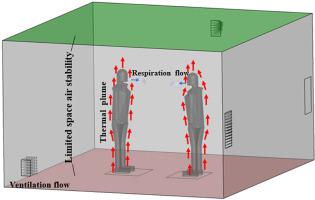International Journal of Thermal Sciences ( IF 4.9 ) Pub Date : 2021-07-15 , DOI: 10.1016/j.ijthermalsci.2021.107173 Xiaorui Deng 1 , Guangcai Gong 1

|
Indoor air stability is a general term that refers to the indoor air's tendency to encourage or discourage its initial inertia motion. In stable conditions where vertical temperature gradients are positive, would prevent the vertical motion of fluid flows, thus the initial inertia motions are maintained, whereas in unstable conditions where vertical temperature gradients are negative, fluids experience intensive convection, thus the initial inertia motions are more easily to get disturbed. This study experimentally and numerically investigated the dispersion of exhaled contaminants and body thermal plume in a displacement-ventilated room integrated with unstable and stable conditions. Two real-human subjects participated in the full-scale experiments. The effects of participants' relative position with reference to the ventilation vents and of ventilation rates on the flow field were examined. Results show that the thermal stratification associated with the displacement ventilation system was disturbed by unstable conditions, resulting in a uniformly distributed contaminants and thermal fields, therefore a reduced exposure level; whereas the thermal stratification was enhanced by stable conditions so that the transport of contaminants and thermal more inclined to follow their initially released direction and led to a relatively high exposure level in the breathing microenvironment. Air distribution in unstable conditions, when compared with stable conditions, was more sensitive to the relative position between the participants and the vents. Increasing the ventilation rate could greatly reduce the contaminant level of unstable conditions but may not achieve as good results in stable conditions. This paper has practical significance in controlling the transmission of exhaled contaminants and preventing the spread of infectious diseases.
中文翻译:

室内空气稳定性对人际呼吸微环境中呼出污染物流量和热羽流的影响
室内空气稳定性是一个通用术语,是指室内空气促进或阻止其初始惯性运动的趋势。在垂直温度梯度为正的稳定条件下,会阻止流体流动的垂直运动,从而保持初始惯性运动,而在垂直温度梯度为负的不稳定条件下,流体经历强烈的对流,因此初始惯性运动更多容易被打扰。本研究通过实验和数值方法研究了在置换通风的房间中呼出的污染物和身体热羽流在不稳定和稳定条件下的扩散。两名真人受试者参与了全面的实验。参与者的影响 检查了相对于通风口的相对位置和流场上的通风率。结果表明,与置换通风系统相关的热分层受到不稳定条件的干扰,导致污染物和热场分布均匀,从而降低了暴露水平;而热分层因稳定条件而增强,因此污染物和热量的传输更倾向于遵循其最初释放的方向,并导致呼吸微环境中的暴露水平相对较高。与稳定条件相比,不稳定条件下的空气分布对参与者和通风口之间的相对位置更为敏感。增加通风率可以大大降低不稳定条件下的污染物水平,但在稳定条件下可能不会达到很好的效果。该论文对控制呼出污染物的传播和预防传染病的传播具有现实意义。











































 京公网安备 11010802027423号
京公网安备 11010802027423号